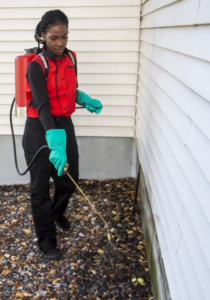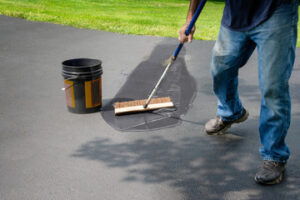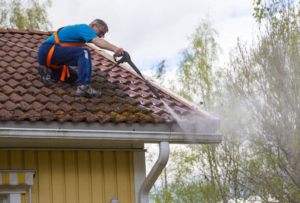Pest Control North Vancouver BC, involves reducing the number of unwanted organisms in your yard or home. This can be done without toxic chemicals damaging your family and planet.
Natural forces affect all organisms, causing their populations to rise and fall. These include climate, natural enemies, and natural barriers. Other factors include food, water, shelter, and overwintering sites.

Pests are organisms that invade and damage landscape and garden plants and crops or cause nuisance problems in the house. They can be ants, spiders, cockroaches, mice, flies, or termites. Pest control aims to minimize the amount of damage caused by these organisms and keep them below damaging levels. Biological methods can control pests, such as predators and parasitoids (which attack or take over other organisms that feed on the pests), barriers, or traps.
Pests need a suitable environment in which to live and reproduce. They can be attracted to a yard by hiding places or food sources or deterred by certain materials or environmental conditions.
Piles of wood, leaf debris, or old garden plants under or around your home attract ants; standing water breeds mosquitoes; pet droppings and rotting garbage attract flies and roaches. To reduce these problems, clean up the area around your house and dispose of garbage regularly.
Planting a variety of vegetables, fruits and ornamentals will keep pests from ravaging any one crop. For example, redroot pigweed will lure blister beetles away from tomatoes, and arugula will lure flea beetles that eat eggplant, brassicas, and potatoes. You can also try using traps to lure pests. Sticky traps made from boards painted yellow and lightly coated with oil or grease catch fruit flies, cucumber beetles, and whiteflies. Citronella candles repel aphids, and crushed eggshells or hydrated lime can discourage slugs.
Biological methods involve encouraging natural predators and parasitoids to control pests. For instance, praying mantises can eat caterpillars; lady beetles, lacewings and robber flies eat aphids; and nematodes (microscopic, worm-like microscopic roundworms) kill caterpillars, cutworms and other garden pests by eating them from the inside out. Some of these organisms are available in garden catalogs and through garden centers.
Another option is to use natural predators, such as birds or snakes, to control pest populations. In addition, pheromones (chemicals that influence other insects of the same species) can be used to lure male pests away from females, which reduces population numbers. Pathogens, such as bacteria like Bacillus thuringiensis that produce toxin that destroys the midgut of caterpillars, are also effective controls for many insect pests.
Kill Pests
Pests like rodents can cause food contamination, contaminate water and damage property. They spread disease and are a major cause of allergies and asthma attacks. Pests also chew wood, destroy the soil and eat seeds, fruit, and crops. They cause a wide range of diseases including plague, hantavirus pulmonary syndrome, Lassa fever, and salmonellosis.
There are several ways to kill pests and control their growth. One method is biological management, which uses natural enemies to reduce pest populations. These enemies include parasitoids, predators, and pathogens. Biological controls are often limited in their effectiveness by a lag between the increase in pest populations and the ability of the enemies to keep up with the increase. Chemicals can be used in combination with these methods to provide more effective control of pests.
Chemicals include herbicides, fungicides, insecticides and nematodes. They are sprayed or placed on plants to kill the target pest. They can be used on crops to protect them from weeds, diseases and insects, as well as in the home to kill pests such as cockroaches and spiders.
While there are a number of household products that can kill or repel pests, these are not as effective as professionally designed and applied pesticides. However, for emergency situations such as a large house centipede or a mouse in the attic, these can be useful. Always be sure to follow the instructions on the product label and be especially careful around children and pets.
Some of the best ways to deter pests include making your property unattractive to them, sealing cracks and crevices, and cleaning. For example, many pests enter homes in search of water, so fixing leaky faucets and drains will help deter them. Also, running a dehumidifier in rooms that are prone to dampness can help.
Other methods include baiting, trapping, and spraying. The specifics of each are dependent on the pest you are trying to control. For example, rodenticides are more effective for rat and mouse infestations than ant baits or diatomaceous earth are for cockroaches. A professional pest control company can identify the type of pest and determine the most effective method of controlling it.
Prevent Pests
It’s a good idea to try to prevent pest problems before they start. This is particularly important in enclosed environments like dwellings, schools and office buildings, health care facilities, food processing and preparation plants, and gardens. Eradication of pests is often impossible in these areas, but prevention and suppression are usually achievable goals.
Preventing pests starts with removing their food, water and shelter. Keep trash cans and other storage containers tightly closed, and remove garbage on a regular basis. Don’t store materials that attract pests, such as paper and cardboard, or things that can provide them with hiding places, such as logs and debris. Fix leaky plumbing, and don’t let standing water accumulate anywhere in or around your home, as this can also encourage pests.
Another important step in prevention is to clean up spills and crumbs as soon as they occur, so that pests are less likely to find them. It’s also a good idea to keep indoor spaces as clutter-free as possible, as this can give pests more places to hide. If you have outdoor areas that come into contact with your buildings, regularly check for and fix any holes or cracks that might allow pests to enter.
Physical pest control methods include traps, bait stations, and other mechanical devices that intercept pests before they can cause damage. The use of these techniques must be judicious, as they can also affect non-target species, such as birds or beneficial insects.
Biological pest controls use natural enemies of the targeted pest, such as parasites, predators or pathogens. This method can be effective, but there is often a time lag between the increase in a pest population and the corresponding rise in its natural enemies. Biological controls can be supplemented with chemical methods, such as the release of sterile males or the use of pheromones to disrupt insect mating behavior.
Chemical pesticides can be effective when other methods fail, but it’s important to remember that these chemicals can also harm humans, pets and wildlife. Therefore, they should be used with great care and always according to the label instructions and safety warnings. It’s generally best to avoid pesticides whenever possible and to select those that are specifically designed for the target pest.
Eliminate Pests
The goal of pest control is to make your home or business unattractive to pests, which will reduce their numbers and damage. There are many ways to accomplish this without resorting to chemicals. For example, putting out baits that attract the pests to trap them or using pheromones to lure them into traps. Physical controls such as removing shelter and food sources and improving sanitation can also help. Before committing to chemical control, however, be sure you know exactly what you are dealing with. For example, a pest you think may be a rodent could actually be a possum. If in doubt, check with Museums Victoria, which offers a pest identification service.
Integrated Pest Management (IPM) is an effective way to control pests in both homes and businesses. It starts with monitoring and scouting to identify pest species and population levels. It then selects the best combination of physical, cultural, biological, and chemical techniques to manage the pests. IPM also considers economic injury thresholds, which determine when action is needed.
There are three goals of pest control: prevention — keeping the number of pests low enough to prevent serious damage; suppression — reducing the numbers of pests to an acceptable level; and eradication — completely eliminating a pest population. Pesticides are the most common means of controlling pests, and they can be used for a wide range of purposes, including killing or repelling insects, fungi, and weeds; disinfecting fruit and vegetables; and treating crops such as tomatoes and cotton with herbicides.
Pesticides are made of synthetic chemicals that kill organisms by disrupting their metabolism or cell structure. They can be sprayed or sprayed onto the plant or poured directly into it. They can also be added to the soil or water supply to protect the plant from pests. In addition to the chemical pesticides, there are biologically derived pesticides, which are natural products such as bacteria and viruses.
There are also resources of a natural origin, such as plant extracts, vitamins and hormones, which work preventively to make plants healthy, as well as pheromones that attract the pests into traps, such as aggregating or sex pheromones.








